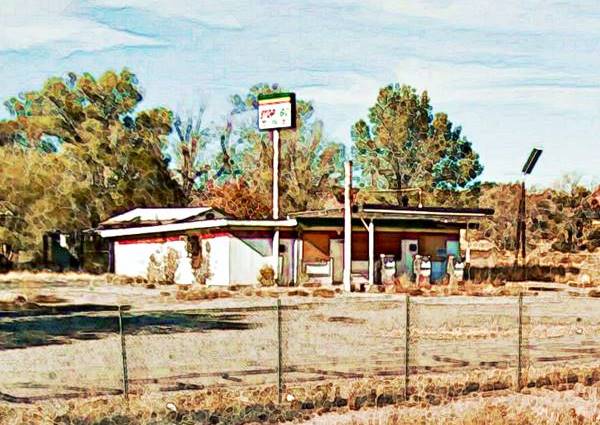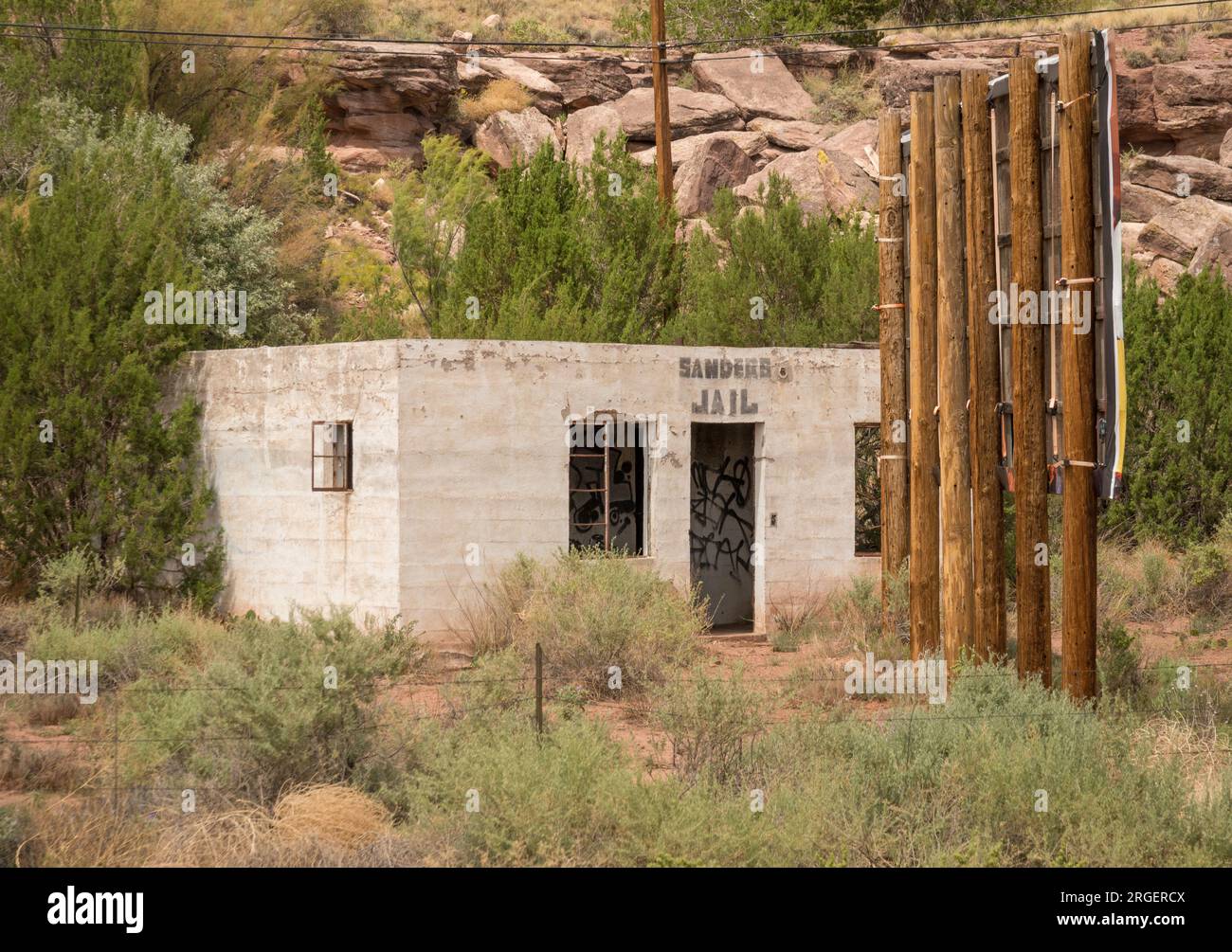
Sanders, Arizona: Where the Mother Road Whispers and Resilience Endures
The sun, a fiery orb, dips towards the western horizon, painting the vast Arizona sky in hues of tangerine and violet. Below, the high desert stretches out, an endless canvas of scrub brush, red earth, and the occasional resilient juniper tree. Here, nestled on the edge of the Navajo Nation, just a stone’s throw from the New Mexico border, lies Sanders, Arizona – a place that time, in many ways, seems to have bypassed. It’s a town of quiet endurance, a testament to the ebb and flow of progress, and a poignant reminder of the America that once thrummed along the legendary Route 66.
For many hurtling down Interstate 40, Sanders is little more than a blur – an exit sign, a cluster of gas stations and truck stops, perhaps a quick pit stop before continuing their journey across the vast expanse of the Southwest. But to dismiss Sanders as merely a waypoint is to overlook a rich tapestry of history, culture, and unwavering spirit that defines this seemingly unassuming community. It is a place where the ghosts of the Mother Road still whisper on the wind, where ancient traditions blend with modern realities, and where the stark beauty of the landscape mirrors the resilience of its inhabitants.
Born of Iron and Dust: The Railroad’s Legacy

Sanders owes its very existence to the relentless westward expansion of the American railroad. Established in the late 19th century as a stop on the Atchison, Topeka and Santa Fe Railway, it was initially known as "Allentown." Its name later changed to honor John B. Sanders, a prominent railroad official, cementing its identity as a crucial link in the iron arteries crisscrossing the nation. The tracks, still active today, serve as a constant, rumbling heartbeat, reminding residents of their foundational history. Towering freight trains, often stretching for miles, rumble through, carrying goods and commodities across the continent, a modern echo of the steam engines that once brought life and commerce to this remote outpost.
The railroad brought workers, settlers, and the promise of a future. It laid the groundwork for what would become a vibrant, if small, community. It was a hub for livestock, a place where ranchers could load their cattle onto trains bound for distant markets. The early days were tough, marked by the harsh desert environment, but the railroad provided a lifeline, connecting Sanders to the wider world and fostering a sense of purpose.
The Golden Age: Route 66 and the Mother Road’s Embrace
However, it was the advent of the automobile and the subsequent paving of U.S. Route 66 in the 1920s that truly brought Sanders into its own. The "Mother Road," as it became affectionately known, wasn’t just a highway; it was a ribbon of hope, adventure, and opportunity stretching from Chicago to Santa Monica. Sanders, strategically located near the Arizona-New Mexico border, became a vital stop for travelers, truckers, and dreamers heading west.
"Back in the Route 66 days, this place was alive," recalls Mary Ann Johnson, a third-generation resident whose family once ran a diner that catered to weary travelers. Her voice, softened by age, carries a hint of nostalgia. "Every type of car you could imagine, every kind of person. You’d see families packed into their sedans, adventurous motorcyclists, cross-country truckers. We had motels, gas stations, diners bustling all day and night. It was a vibrant, hopeful time."
During its heyday, Sanders was more than just a place to refuel; it was a microcosm of Americana. Roadside attractions, albeit modest, dotted the landscape. Small trading posts, selling Native American crafts and curios, flourished. The sound of car engines, laughter, and the clatter of plates in diners filled the air. It was a place where stories were exchanged, where weary travelers found respite, and where the promise of the West felt palpable. Sanders was a living postcard from an era of open roads and endless possibilities.
The Bypass and the Quiet Aftermath
But progress, as it often does, is a double-edged sword. In the late 1960s and early 1970s, the federal government embarked on the ambitious project of constructing the Interstate Highway System. Interstate 40, a modern, faster, and more efficient artery, was built parallel to and eventually bypassed large sections of Route 66. For towns like Sanders, this meant a dramatic shift in fortune. The steady stream of traffic, the lifeblood of its economy, was diverted.

"When I-40 opened, it was like someone turned off a faucet," Johnson explains, her gaze drifting towards the old, now-shuttered motel sign across the street. "The travelers just… disappeared. They didn’t need to come through the town anymore. They just sailed right past us on the interstate. It was hard. Many businesses couldn’t make it."
The bypass left a profound mark. Motels closed, diners went dark, and the bustling energy of Route 66 faded into memory. Sanders, like countless other small towns along the Mother Road, faced an existential crisis. Its population dwindled, and a sense of quiet resignation settled over the community. The remnants of its past glory became poignant reminders of a bygone era – crumbling motel foundations, faded paint on old storefronts, and the silent stretch of the original Route 66, now a local road, often carrying more tumbleweeds than cars.
A Crossroads of Cultures: The Navajo Connection
Yet, Sanders never truly became a ghost town. Its enduring spirit is deeply intertwined with its unique cultural makeup. Situated on the border of the Navajo Nation, the largest Native American reservation in the United States, Sanders is a vibrant crossroads where Anglo and Navajo cultures meet and blend. Many residents are Diné (Navajo), bringing with them a rich heritage, language, and a profound connection to the land.
"We have always been here," says Raymond Begay, a Navajo elder and a lifelong resident, speaking softly in a mixture of English and Diné Bizaad. "Our traditions, our stories, they are rooted in this land, in these rocks, in these skies. Sanders is our home, whether the road goes through it or around it. We adapt. We always have."
This cultural intermingling is a defining characteristic of Sanders. Navajo language can be heard alongside English in local stores. The intricate artistry of Navajo rugs and jewelry is often displayed in the few remaining trading posts. The resilience of the Navajo people, who have weathered centuries of change and challenge, mirrors the town’s own perseverance. This deep cultural foundation provides a bedrock of stability and identity that transcends economic downturns.
Sanders Today: Resilience in the Desert
Today, Sanders is a place of stark contrasts. Along the Interstate, modern truck stops and gas stations cater to the constant flow of traffic, providing the bulk of the town’s economic activity. These hubs are vital, offering employment and essential services to both residents and travelers. But venture off the main highway, onto the original Route 66, and you enter a different world. Here, the pace slows dramatically. Modest homes, some well-maintained, others showing the wear of time, line the quiet streets. A post office, a small convenience store, and a local school serve the community’s needs.
The natural landscape remains a dominant feature. The elevation, around 6,000 feet, provides cooler temperatures than the low desert, but the environment is still arid and challenging. Vast, star-dusted skies at night offer a breathtaking spectacle, a testament to the town’s isolation from major light pollution. The nearby Petrified Forest National Park and the Painted Desert offer stunning geological wonders, drawing some tourists to the area who might then pass through Sanders. Further afield, the majestic Canyon de Chelly National Monument, a sacred place for the Navajo people, is also within reach, reinforcing Sanders’ role as a gateway to the rich cultural and natural heritage of the region.
"It’s not a place for everyone," admits Sarah Chen, who manages one of the truck stops. "It’s quiet. Sometimes, it feels forgotten. But there’s a real sense of community here. People look out for each other. And for those who appreciate the quiet, the vastness, the history – there’s a beauty to it you won’t find in the big cities."
The future of Sanders, like many small towns, is uncertain but not without hope. There’s a growing interest in preserving the historical integrity of Route 66, bringing a trickle of nostalgic travelers back to its original path. These "road trippers" are often seeking the authentic, unvarnished America that places like Sanders represent. They stop, they explore, they buy a souvenir, and they leave with a deeper appreciation for the towns that refuse to fade away.
Sanders, Arizona, is more than just a dot on a map or an exit sign on a highway. It is a living monument to the enduring spirit of the American West. It is a town that has weathered the storms of progress, adapting and persisting, drawing strength from its unique history and its interwoven cultures. As the sun rises over the vast desert, casting long shadows across the old Route 66 and the new Interstate 40, Sanders stands as a quiet testament to resilience – a place where the whispers of the past mingle with the quiet determination of the present, and where the heart of the Mother Road continues to beat, albeit softly, in the vast, open spaces of Arizona.


